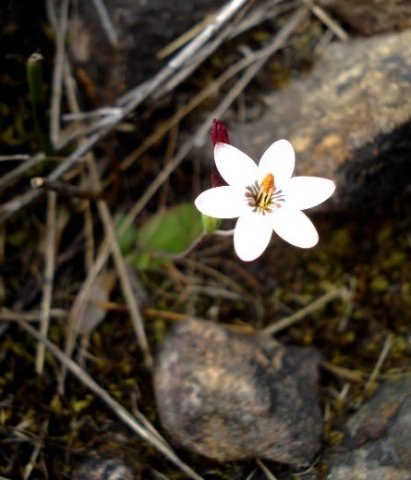Geissorhiza

Author: Ivan Lätti
Photographer: Judd Kirkel Welwitch
Geissorhiza is a genus of cormous, deciduous perennials in the Iridaceae family, commonly known as satinflowers.
The corms are globose to ovoid, bell-shaped to asymmetrical, covered in mostly woody tunics, while some are membranous or fibrous. The generic name, Geissorhiza is derived from the Greek words geisson meaning tile and rhizon meaning root, referring to the overlapping corm tunics. There is usually a ridge at the corm base from which the roots grow.
The annual stem is cylindrical, sometimes branched and may be hairy. This flowering stem droops when in bud.
The lowest two or three leaves are cataphylls. A cataphyll is a reduced scale leaf, bract or bracteole, differing from a plant’s true leaves, adapted for other functions than photosynthesis. The normal leaves usually have raised midribs, sometimes ridged margins or are rounded in cross-section. The usually narrow blades may be hairy or sticky.
The inflorescence is mostly a spiralling spike but occasionally flowering solitary on branches. Two green, soft-textured or membranous bracts subtend each flower, the inner one smaller than the outer, both notched at their tips.
The variously shaped and coloured flowers may be blue, purple, pink, white, yellow, red or bicoloured. The corolla tubes are funnel-shaped to cylindrical and vary in length. The inner tepals are usually shorter than the outer ones, the tepals spreading or forming a cup. The flowers are not fragrant but some produce nectar.
The stamens are erect or flexed down, their filaments thread-like, sometimes of unequal length. The three-locular ovary is inferior, its style thread-like, ending in three branches that are variously orientated although often short and recurved.
The fruit capsule is globose to cylindrical. The seeds are angular to globose, their surfaces variable from smooth to wrinkled across the species.
The about 85 Geissorhiza species are South African, most of them occurring in the Western Cape and 80 in the fynbos. Some species feature in horticulture.
The plant in picture is Geissorhiza ovata (Leistner, (Ed.), 2000; Curtis-Scott, et al, 2020; Manning, 2007).

